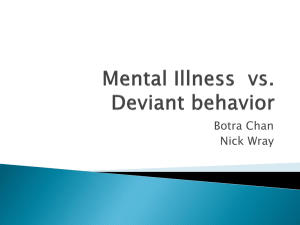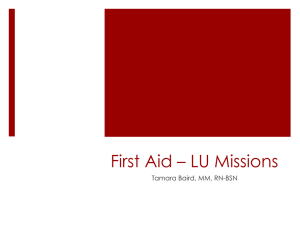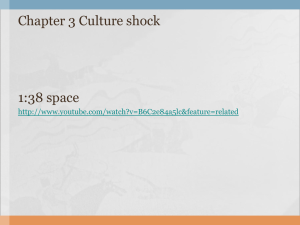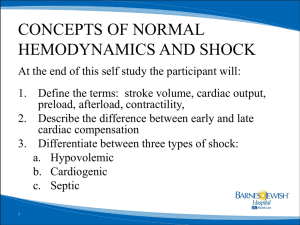Shock Lecture
advertisement
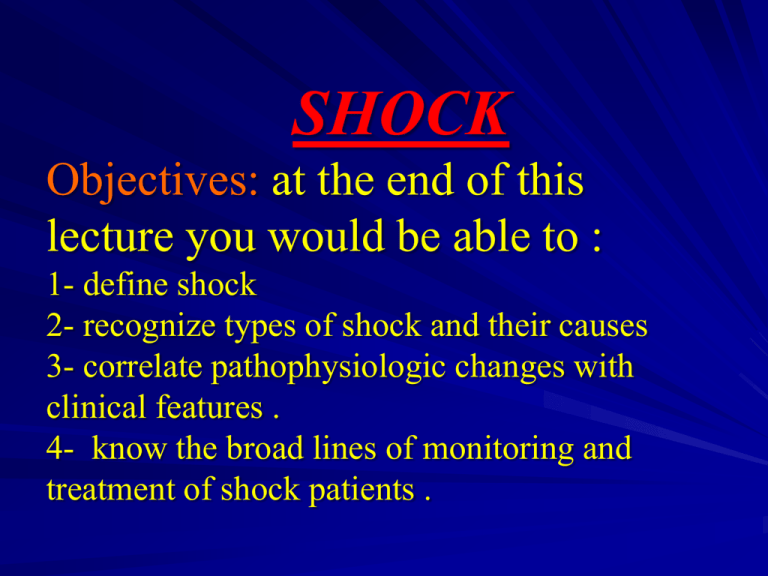
SHOCK Objectives: at the end of this lecture you would be able to : 1- define shock 2- recognize types of shock and their causes 3- correlate pathophysiologic changes with clinical features . 4- know the broad lines of monitoring and treatment of shock patients . Shock A physiological state characterized by a significant, systemic reduction in tissue perfusion, resulting in decreased tissue oxygen delivery and insufficient removal of cellular metabolic products, resulting in tissue injury. SHOCK Definition: SHOCK is an acute circulatory failure, characterized by dysfunction of the microcirculation , inadequate blood flow to vital organs and inability of the body cell mass to metabolize the nutrients normally. Shock is not a synonym to hypotension! What are the functions of the cardio-vascular system? Definition of Shock Cellular level: Reduction of mitochondrial oxygen Anaerobic glycolysis of ATP Accumulation of pyruvate Lactatic Acidosis SHOCK Classification of Shock A- Classification of Shock by Causes (1) Hypovolemic shock (2) Cardiogenic shock (3) Neurogenic shock (4) Anaphylactic shock (5) Septic shock B. Classification of Shock according to hemodynamic changes: ⑴Hypodynamic Shock: Cardiac Output , Vascular Resistace, Cold Skin; ⑵ Hyperdynamic Shock: Cardiac Output , Vascular Resistace , Warm Skin; Different kind of Reason Inadequate Blood Flow Circulatory Failure Metabolic Disturbances Special Clinical Syndrome Systemic pathophysiologic responces of Shock Redistribution of blood flow Low blood flow Skin,fat,skeletal muscls,kidney,intestines Heart,brain normal or Etiology & Hemodynamic Changes in Shock Etiology of shock preload example CVP CO SVR VO2 sat hypovolemic low low high low contractility cardiogenic high low high low afterload distributive Etiology & Hemodynamic Changes in Shock (Afterload) ETIOLOGY OF SHOCK EXAMPLE AFTERLOAD DISTRIBUTIVE CVP CO SVR VO2 SAT Hyperdynamic Septic Low/High High Low High Hypodynamic Septic Low/High Low High Low/High Neurogenic Low Low Low Low Anaphylactic Low Low Low Low Hypovolemic Shock Decreased preload→small ventricular enddiastolic volumes →inadequate cardiac generation of pressure and flow Causes: -- bleeding: trauma, GI bleeding, ruptured aneurysms, hemorrhagic pancreatitis -- protracted vomiting or diarrhea -- adrenal insufficiency; diabetes insipidus -- dehydration -- third spacing: intestinal obstruction, pancreatitis, cirrhosis Classes of acute hemorrhage Class I Class II Class III Class IV Blood loss < 750 cc 0-15% 750-1500 15-30% 1500-2000 30-40% >2000cc >40% HR Normal PP Normal BP Normal Normal UOP Normal Normal Decreased Negligible Mental Normal Anxious Confused Lethargic Crystalloid Crys+blood Crys+blood Fluid Crystalloid *ATLS; 2004. 70kg male Signs & Symptoms: Hypotension, Tachycardia, change, Oliguria, Deminished Pulses. Markers: monitor urine output UOP, central venous pressure CVP, blood pressure BP, heart rate HR, hemaocrit Hct, mental state MS, cardiac outputCO, lactic acid and pulmonary capillary wedge pressurePCWP Treatment: IVF (crystalloid), Trasfusion , Stem ongoing Blood Loss TRUE OR FALSE ? The earliest sign of hypovolemic shock is hypotension . TRUE OR FALSE In early stage of hypovolemic shock the skin would be warm due to vaso-dilation . Septic/Inflammatory Shock This type is due to infection/sepsis: G(-/+ ) speticemia, pneumonia, peritonitis, meningitis, cholangitis, pyelonephritis, necrotic tissue, pancreatitis, wet gangrene, toxic shock syndrome, etc. Mechanism: It is due to release of inflammatory mediators which leads to 1-Disruption of the microvascular endothelium 2-Cutaneous arteriolar dilation and sequestration of blood in cutaneous venules and small veins Signs: Early– warm with vasodilation (hyper dynamic circulation), often adequate urine output, fever and tachypnea. Late-- vasoconstriction, hypotension, oliguria, altered mental status (hypodynamic circulation). Findings: Early : hyperglycemia, respiratory alkalosis, hemoconcentration, WBC typically normal or low. Late : Leukocytosis, lactic acidosis VeryLate :Disseminated Intravascular Coagulation & Multi-Organ System Failure. Treatment : Intravenous fluid IVF, Blood transfusion, antibiotics, Drainage (ie abscess) vasopressor agents . TRUE OR FALSE In hyperdynamic state of septic shock there is rapid washout of metabolites because of increased blood supply to the tissues Cardiogenic Shock Mechanism: Intrinsic abnormality of heart → inability to deliver blood into the vascular tree with adequate power Causes: 1. Cardiomyopathies: myocardial ischemia, myocardial infarction, cardiomyopathy, myocardiditis, myocardial contusion 2- Mechanical: cardiac valvular insufficiency, papillary muscle rupture, septal defects, aortic stenosis 3- Arrythmias: bradyarrythmias (heart block), tachyarrythmias (atrial fibrillation, atrial flutter, ventricular fibrillation) 4- Obstructive disorders: pulmonary embolism PE, tension peneumothorax, pericardial tamponade, constrictive pericaditis, severe pulmonary hypertension Signs and symptoms : Dyspnea, rales, gallop, low BP, oliguria Monitor/findings: CXR pulmonary venous congestion, elevated CVP, Low CO. Treatment : this will be according to cause eg Congestive heart failure CHF– diuretics & vasodilators +/- pressors. Left ventricular LV failure – pressors , decrease afterload, intraaortic ballon pump & ventricular assist device. Neurogenic Shock Mechanism: Loss of autonomic innervation of the cardiovascular system (arterioles, venules, small veins, including the heart) Causes: *Spinal cord injury *Regional anesthesia *Drugs * Neurological disorders Characterized by loss of vascular tone & reflexes. Signs: Hypotension, Bradycardia, Accompanying Neurological deficits. Treatment : IVF, vasoactive medications if refractory Anaphylactic shock: This type occurs due to binding of a foreign antigen to immunogloin E (IGE) on the mast cells and basophils , releasing large amounts of histamine and SRS-A ( slowrelease substance-anaphylaxis) which will produce bronchospasm , laryngeal edema and respiratory distress with hypoxia , massive vasodilatation hypotension and shock.This type occurs on exposure to penicillin , anesthetic drugs , serum Monitoring of shock 1-General monitoring Heart rate Breathing Monitoring of shock 2.Colour and temprature of skin Monitoring of shock 3.BP Systolic Pressure was lower than 12kPa(90mmHg) 4. Urina Oliguria Monitoring of shock Special monitoring 1.CVP 5-10cmH2O CVP<5cmH2O Inadequecy of blood volume CVP>12cmH2O Cardiac dysfunction 2.Lung arterial pressure 3.Cardiac output 4.Blood gas PO2 75-100mmHg Pco2 40mmHg PH 7.35—7.45 5.Coagulation test Treatment of the shock Position of Body 30。 TRUE OR FALSE * shock in intestinal obstruction is multifactorial .


![Electrical Safety[]](http://s2.studylib.net/store/data/005402709_1-78da758a33a77d446a45dc5dd76faacd-300x300.png)
